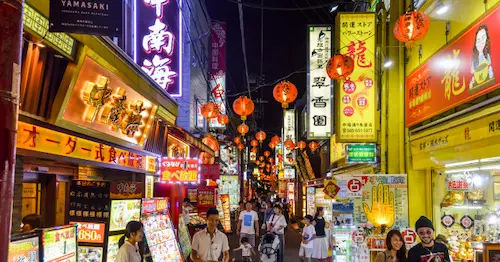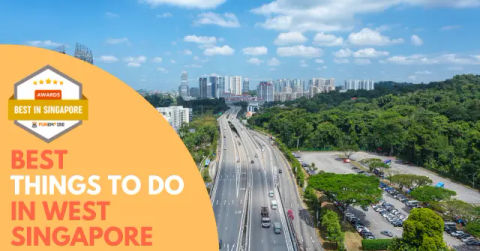Chinatown Singapore

Welcome to Chinatown Singapore! This place is full of olden history but rich traditional culture, places, and food.
This area earned its name from its strong Chinese heritage where people can explore the streets lined with stores from various parts of China, colorful temples, busy markets that sell flowers famous exotic food, and various exclusive products.
If you are a fan of the history of Temple Street show, ethnic food, or even just curious about it, Chinatown Singapore surely has it for you.
With its mix of olden and modern attractions, it draws in the locals as it does the tourists who are looking for things to do in Singapore.
Quick Summary
- The Buddha Tooth Relic Temple is the standout attraction in Chinatown Singapore, offering stunning architecture and a deep dive into Buddhist culture.
- Chinatown Singapore seamlessly blends rich cultural heritage with modern attractions, making it an ideal destination for both history enthusiasts and urban explorers.
- Chinatown Singapore is a vibrant district where the past and present converge, offering a unique experience through its diverse culinary scene, historic temples, and bustling markets.
Getting to Chinatown

Chinatown is very accessible by MRT and other forms of transportation. The easiest way is to use the MRT and take Chinatown MRT Station (NE4/DT19) on the North East Line and Downtown Line.
You can also choose the option of buses and taxis. The best time to visit is the early mornings or late afternoons when the weather is milder and the street has much fewer people.
Chinatown is a short walk from CBD, if you prefer walking, 15- 30 minutes walk from working place. You can take some time and explore Singapore with Chinatown on the list for a day trip.
Food and Drink

Traditional Chinese Cuisine
- Oriental Chinese Restaurant: Tastebe buds will savor the pleasure of Oriental flavors such as duck, Kung Pao, and other traditional dishes. The feeling of appetite is assured to increase because of the not-fake dried fish, meat, vegetable dishes whose flavor is distinctively Chinese.
- Chilli Pan Mee: One of the well-known Chinese noodles that is made up of nine flavors spicy, rich, and umami. This dish is the best representation of Chinese cuisine, as it features chilly, dried anchovies and delicious noodles.
Dim Sum and Hawker Centres
- Yum Cha: Famed for its dim sum, this is among the first places most tourists visit, and a regular haunt for locals for dinner. Five different types of steamed buns. Squid ink dumplings. Shiitake-and-tofu turnovers. These are just some of the options, a rotating cast of thousands.
- Chinatown Complex Food Centre: This is the largest hawker centre in Singapore, we believe there are 263 food stalls selling everything here, everything we can think of, Hainanese Chicken Rice and then here they sell this Satay. It is what i would call food paradise where you can try what ever you want to eat.
Specialty and Unique Eats
- Li Ji Chuan Chuan Xiang: Experience the joy of a hot pot with an array of skewered meats and vegetables. This dining experience is interactive and fun, allowing you to cook your selections in a flavorful broth right at your table.
- Don Dae Bak: Enjoy Korean BBQ in the heart of Chinatown, a perfect spot for meat lovers. The combination of marinated meats and various side dishes provides a satisfying and flavorful meal.
Cafés and Dessert Spots
- Mei Heong Yuen Dessert: Cool off with traditional Chinese desserts like almond paste and snow ice. These icy treats are a refreshing way to beat the heat in Singapore and they make a nice ending to any meal.
- The Food Peeps Coffee and Deli: A coffee shop serving yummy deli sandwiches. a cosy place where you can sit
Shopping in Chinatown

Traditional Markets and Shops
Yue Hwa Chinese Products
This sprawling Chinese department store brings the Old World markets of China and the replica imperial palaces to downtown. The array of gifts and souvenirs, from Chinese herbal medicines to silk jackets and lanterns on its upper level, form a portable Chinatown perfect for those seeking gifts and unusual treasures.
Pagoda Street Market
Clothes, nicknacks, trinkets, toys, more toys, souvenirs – you name it. This open-air street market beside Chinatown is a pleasant walk, and you’re sure to escape with plenty of holiday knickknacks at a good discount if you stop to shop.
Unique Boutiques

Tintin Shop
If you’re a Tintin fan, you need to come to the Tintin Shop, which is for Tintin lovers only! Everything Tintin is there: all type of merchandising and the most exclusives.
The Social Space
A boutique specialising in retail therapy with an added café to furnish delicious, quick snacks. Now you can feel rightful in your environmental and socially responsible worship by shopping with a conscientious conscience.
Things to Do and See
Take Part In An Amazing Race Around Chinatown

If you’re looking for the best way to explore Chinatown and have fun at the same time, consider booking an Amazing Race with FunEmpire.
The activity will take you and your team around key locations in Chinatown, solving puzzles and learning about history and culture while allowing you to bond and create memories together.
It’s definitely a good option if you’re looking for team building activities in Singapore!
Cultural and Historical Sites

- Buddha Tooth Relic Temple: Built around a sacred relic of the historical Buddha himself, this exquisite temple is definitely worth a visit for its architecture and its spiritual atmosphere. It is in some way more peaceful to be here, in this ornate cell, than it would have been had you been eating in any old café back in the city streets from which you’ve come.
- Sri Mariamman Temple: It is the oldest Hindu temple in Singapore, dating back to 1827. Local legend says that the gopuram (tower) made its way from India in smaller pieces, and was put together by Chinese carpenters. A jewel of Dravidian (South Indian) architecture in this land of skyscrapers, Sri Mariamman Temple is a gem of multicultural Singapore.
- Fuk Tak Chi Museum: Once a temple, a mosque street now a museum, it offers insights into the lives of early Chinese immigrants. The exhibits provide a fascinating glimpse into the history and culture of Singapore’s Chinese community.
Art and Architecture

- Street Murals by Yip Yew Chong: These murals beautifully capture the essence of old Chinatown and are perfect for photo opportunities. The detailed and colorful artwork tells stories of the past, adding a vibrant touch to the neighborhood.
- Architectural Landmarks: Explore the unique blend of old and new in Chinatown, from traditional shophouses to modern buildings. The architectural diversity reflects the area’s rich history and ongoing evolution.
Nightlife and Entertainment

Chinatown comes alive after the sun sets. Clubbing, bars and a large variety of smiley faces crowd Potato Head Singapore and Dorothy’s Bar. Here you can find all kinds of potent drinks spun with mellow music and a great ambience.
The numerous night markets are also well worth visiting for a wide selection of street food and quirky items, neatly arranged together with many street performances.
The nightlife in Chinatown adds a new dimension to this place where one can experience for oneself the liveliness that they talk about with great enthusiasm.
Practical Tips
- Safety and Etiquette: Chinatown is in general safe. Basically, when in doubt, cover up and don’t wear shoes in the temple. Leave your shoes outside all the temples. Sit down on a tiny stool. No talking in the temple and don’t flash too much.
- Budgeting for Your Trip: There’s always the option of heading to Chinatown, where you can get anything from cheap hawker stalls to unbelievably expensive dining establishments. Lay your plans according to your budget – otherwise, stick to the hawker centers and enjoy great meals without stretching your wallet too much.
- Language and Communication: English is widely understood, but if you know a few basic Mandarin phrases, it will make your experience better. Greetings and other simple phrases will go a long way.
Chinatown Singapore
There are culinary treats to fetch and vistas to reimagine, all served on a platter of history and culture, in one secluded precinct. Chinatown Singapore – an ocular, gastronomic, and cultural smorgasbord that will dazzle and delight your senses.
Sight, taste, and shopping must all converge in the labyrinthine, bustling streets of Chinatown. Come with travel back and an appetite, bring your ears and your eyes, and take with you a sense of all things Singapore.
Check out some of our other related articles and guides below:
- Best Things to Do in Singapore (2025)
- Best Indoor Activities in Singapore (2025)
- Best Outdoor Activities in Singapore (2025)
- Ultimate Guide To Botanic Gardens Singapore (2025)
- Ultimate Guide To Bukit Timah Nature Reserve Singapore (2025)
- Ultimate Guide to Chijmes Singapore (2025)
- Ultimate Guide to Clarke Quay in Singapore (2025)
- Ultimate Guide to East Coast Singapore (2025)
- Ultimate Guide to Fort Canning Park Singapore (2025)
Frequently Asked Questions
What are the must-try foods in Chinatown?
Chilli Pan Mee, dim sum at Yum Cha, and desserts from Mei Heong Yuen Dessert comprise a few attractions on offer.
How do I get to Chinatown from the airport?
Take the MRT from Changi Airport, transfer to the East-West Line, then transfer to the North East Line to Chinatown MRT Station. Taxis and a shuttle service are available for a more direct journey
What are the operating hours for major attractions?
Most temples and museums open from 9 AM to 6 PM. However, it’s best to check individual websites for exact times. Some attractions may have extended hours during festivals or special events.
Are there any special events in Chinatown?
Yes, Chinatown hosts events such as the Chinese New Year bazaar and Mid-Autumn Festival celebrations. These events feature vibrant decorations, cultural performances, and a variety of street food carts and stalls, offering a unique festive atmosphere.
What is the best time of year to visit?
Visiting during Chinese New Year or Mid-Autumn Festival offers a unique and festive experience, though it can be crowded. Otherwise, the cooler months from December to February are ideal. During these times, the weather is more pleasant, making it easier to explore the area.






